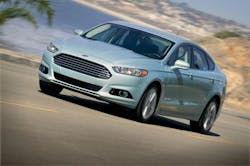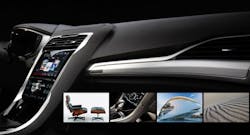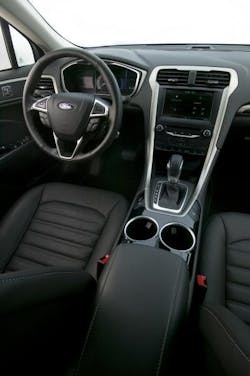I mean, we’re going beyond mere stability control and other safety functions here: I’m talking about vehicles that continuously monitor traffic congestion levels and then decide whether or not to allow your cell phone to receive calls. Or where vehicles measure the “stress level” of the driver at the controls, thus adjusting the level of “help” the vehicle might provide.
It may be one thing to joke about “Big Brother” being built into today’s vehicle, but it’s quite another to realize Orwell’s all-pervasive entity might actually be stitched into the driver’s seat!
Take Ford Motor Co.’s new 2013 Fusion sedan as an example; this is a vehicle equipped with more than 145 actuators, 4716 signals, and 74 sensors including radar, sonar, cameras, accelerometers, temperature and even rain sensors, according to Paul Mascarenas, the OEM’s VP and chief technical officer.Incredibly, he noted that those sensors produce more than 25 gigabytes of data per hour which is analyzed by more than 70 on-board computers in the Fusion – data that helps in part to monitor the perimeter around the car and see into places that are not readily visible from the driver's seat.
"So far we've just scratched the surface of what is possible," said Mascarenas. "In the Fusion, we have sensors and actuators that act independently as part of the assist features. The next phase, currently in research, involves sensor ‘fusion,’ where engineers learn how to more comprehensively characterize the environment by blending multiple signals, and add externally available information through cloud connectivity."
That kinda sounds to me like they’re getting the car ready to do its own thinking – and not just about how to improve safety, mind you. Check out these ideas Mascarenas and his team of engineers are exploring at Ford (ideas no doubt being worked upon by all automakers in some fashion or another):- "Big data" analysis and intelligent decision making: He said Ford is researching the use of real-time sensor data – radar and camera-based – that can help evaluate external factors affecting driver attention, such as traffic congestion, and thus limit potential distractions such as an incoming phone call;
- Upgradeable, customizable hardware: Mascarenas noted that Ford's OpenXC research platform looks at the potential for open-source, community-driven innovation of plug-and-play hardware modules that provide infinite opportunities for rapid customization;
- Seamless integration across cloud ecosystems: The company wants to take its SYNC “agnostic” platform strategy that for mobile devices and do the same for the consumer shift toward cloud-based services;
- Advanced machine learning: The new Fusion and C-MAX Energi plug-in hybrids utilize EV+, a feature that learns the typical locations of charging, such as home and office, and then automatically maximizes electric-only driving mode when nearing those locations;
- Biometrics: Mascarenas stressed that Ford is researching biometric sensors, such as those embedded in a car seat, to measure stress levels for a more personalized response from driver assist technologies, because skill levels – and thus stress – can vary in certain situations;
- Prediction: Ford researchers are looking at ways to predict driver behavior, such as a driver's destination based on prior history, to help optimize and configure vehicle controls for improved performance such as better energy management;
- Rapid data authentication: Ford sees significant potential in vehicle-to-vehicle communications and is actively researching the technology globally, including advanced Wi-Fi with rapid authentication capability so that cars can exchange information quickly and securely, helping drivers avoid potential collisions.
Whoa. That’s some pretty heavy stuff if you ask me. I can imagine cars and trucks one day telling me NOT to pull into the McDonald’s because, hey, that food is bad for me – and if I do anyways, it’ll restrict vehicle speed to 50 mph. OUCH!



